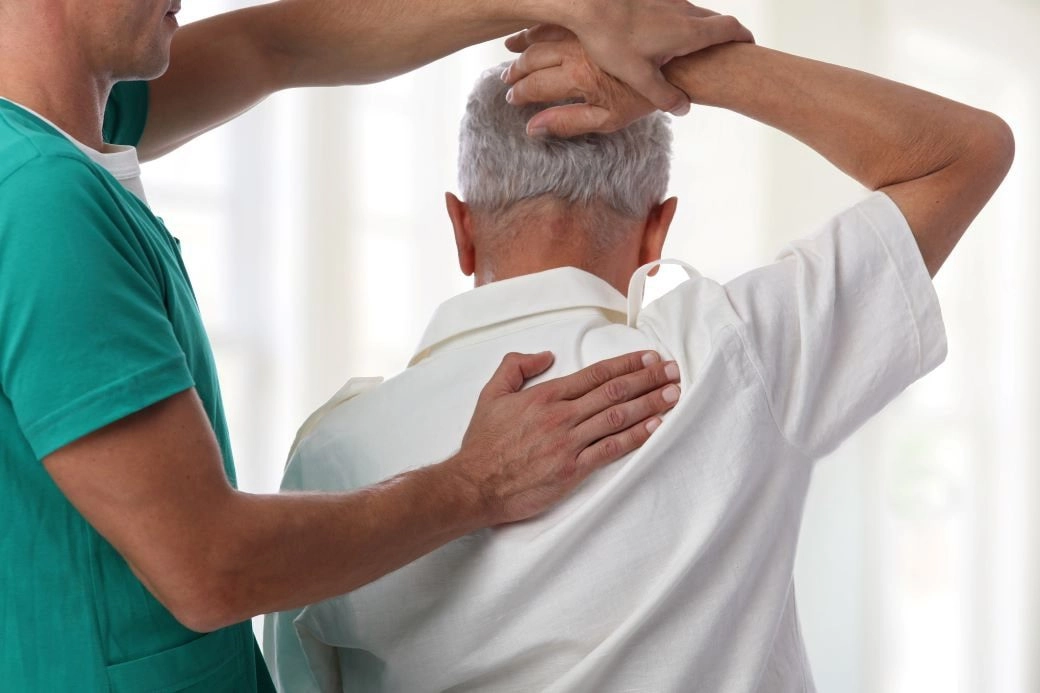There are three different portions of the spine: lumbar (lower back), thoracic (middle back), and cervical (neck). Each of these areas is susceptible to degradation and damage, but some more than others. Spondylosis can affect all three spinal sections, but we’ll discuss thoracic spondylosis in this article.
Thoracic spondylosis is a term for arthritis of the middle portion of the spine. As we age, the bones, cartilage, tendons, and discs of the spine can all degrade. When this happens in the middle back area, it’s known as thoracic spondylosis.
What Is Thoracic Spondylosis?
As mentioned above, thoracic spondylosis happens when the spinal vertebrae of the thoracic region degenerate. There are a number of things that can be identified as thoracic spondylosis. These include:
- The thinning of discs between the spinal vertebrae
- Narrowing of the openings where nerves exit the spine
- Developing bone spurs
- Fractures of the bones in the spine
- The thickening of ligaments, preventing flexibility
Thoracic spondylosis is less common than lumbar or cervical spondylosis. However, this type of spondylosis is more likely to develop if other areas of the spine develop spondylosis.
What Is Mild Thoracic Spondylosis?
Mild thoracic spondylosis happens when the degeneration of this spinal segment is minimal, often causing few or no symptoms at all. But even if there are no obvious symptoms, it’s important for those with mild thoracic spondylosis to be proactive to prevent the condition from going from mild to severe, as is likely to happen over time without proper treatment.
What Causes Thoracic Spondylosis?
The wearing down of the bones is a normal part of aging. However, an active lifestyle, sports injuries, and general wear-and-tear on the spine can make thoracic spondylosis more likely as you age.
Some people are more likely to develop this condition than others, thanks to their genetic makeup. And while overweight people are more likely to develop this type of arthritis, this is mainly because of the extra weight on the spine, which puts pressure on the vertebrae consistently for years. An inflammatory diet can also make the symptoms of any type of spondylosis worse, as it is often accompanied by inflammatory back pain.
Thoracic Spondylosis Symptoms
There are not always symptoms associated with thoracic spondylosis. Some people may have it without even knowing it, while others will be in pain thanks to the condition — even if their spondylosis isn’t considered severe. Some common symptoms include:
- Stiffness in the middle-back area
- Soreness in the middle back
- Pain radiating down the back and/or legs
- Weakness in the legs or arms
- Tingling in the limbs
- Loss of fine motor skills (often dropping things or problems walking)
- Increased pain with activity
Those with thoracic spondylosis may experience some or none of these symptoms. The most severe cases may result in problems with fine motor skills and severe pain, but not always.
Can Thoracic Spondylosis Cause Chest Pain?
Much of the pain from spondylosis is caused by pressure on nerves exiting the spinal cord. When the spinal canal narrows, it can cause pain that radiates to other parts of the body, including the chest, abdomen, arms, legs, and neck. Since spondylosis often comes with the weakening and compression of the discs between vertebrae, pinched nerves can also be caused by bulging or herniated discs.
Is Thoracic Spondylosis a Disability?
Like many other back issues, thoracic spondylosis could be a disability if it’s deemed disruptive enough that you can no longer work or function. This is not to say that everyone with thoracic spondylosis can or should go on disability. However, in severe cases, it could be the best option to get the time you need to seek proper care while preventing further damage from your work activities.
Most people with thoracic spondylosis will not need to seek disability. Instead, it’s best to seek help from a professional chiropractor, who can help you determine the best steps for recovery.
What Does Thoracic Spondylosis Without Myelopathy Mean?
Myelopathy refers to compression and damage of the spinal cord. When thoracic spondylosis causes bone spurs to form, compressing the spinal cord, this is known as a form of thoracic spondylosis with myelopathy.
So thoracic spondylosis without myelopathy simply means that there is no damage to the spinal cord. Much of the time, myelopathy is the cause of serious symptoms such as numbness, trouble with motor skills, pain in the chest, and sometimes even trouble controlling the bowels or bladder.
Those who have thoracic spondylosis without myelopathy will simply need to take precautions to ensure that they don’t develop damage to the spinal cord over time. This is one of the things a chiropractor can help with, as prevention and treatment are both parts of what chiropractors do.
What Are the Treatments for Thoracic Spondylosis?
Most patients will undergo conservative treatments first unless they have particularly severe symptoms, in which case surgery may be the only option for relief. Most treatments for thoracic spondylosis are all about relieving pain and then strengthening the core, which is unparalleled in helping keep the spine healthy.
Some people who suffer from thoracic spondylosis may also experience spondylolisthesis, where one vertebra slips out over another. In these cases, a chiropractic back adjustment is a major treatment protocol.
For those without spondylolisthesis, the typical course of treatment mainly involves physical therapy and exercises designed to strengthen and protect the areas around the spine. It may also require over-the-counter anti-inflammatory drugs.
Luckily, most people respond well to treatment options offered by chiropractors and physical therapists. This means that risky treatment options, like surgery, aren’t usually necessary.
However, it’s important to see a chiropractor if you suspect you have spondylosis, even if you don’t yet have any symptoms.
The importance of this is outlined in a study about a chiropractor who caught spondylosis with myelopathy in a 58-year-old male. The chiropractor saw how severe the problem was and referred the patient to a surgeon before any permanent damage was done. Without the thorough chiropractic exam, the patient likely would not have gotten the care he needed in time.
Chiropractic Care as Preventative Care
Since age-related wear and tear is one of the main factors determining the development of thoracic spondylosis, it’s never too early to start caring for your spine — or too late. In fact, one study looking at the difference between chiropractic care and standard medical care for older adults found some interesting conclusions.
Those who saw chiropractors were less likely to have interruptions in activities of daily living and more likely to report better overall health. The authors of the study suggested that seeing a chiropractor regularly is an effective form of preventative care.
Perhaps the best part is that chiropractors work with physical therapists to teach their patients exercises and stretches to do at home to protect their backs. They also provide tips on staying generally healthy. If you need to see the best Juneau chiropractor that offers a no-more-than-10-minute-wait promise, contact us at our Better Health Juneau office.
Thoracic Spondylosis: Conclusion
Thoracic spondylosis has several risk factors, and anyone can suffer from it. It’s a form of arthritis that develops in the middle spine, and can cause symptoms ranging from minor to severe. In some, there are no symptoms at all.
Since older adults are more likely to develop thoracic spondylosis, it’s important that they take steps to keep their spines healthy. This includes seeing a chiropractor regularly and living a healthy, active lifestyle.
Chiropractic Care and Physical Therapy for Thoracic Spondylosis
For many of our patients with thoracic spondylosis, the Alaska Back Pain Procol is an effective treatment. It helps improve quality of life and prevents serious degeneration from this condition. Click the link above to find out more!
Resources:
https://pubmed.ncbi.nlm.nih.gov/3587552/
https://www.sciencedirect.com/science/article/abs/pii/S1360859221001984
https://www.sciencedirect.com/science/article/abs/pii/S0161475414000323









